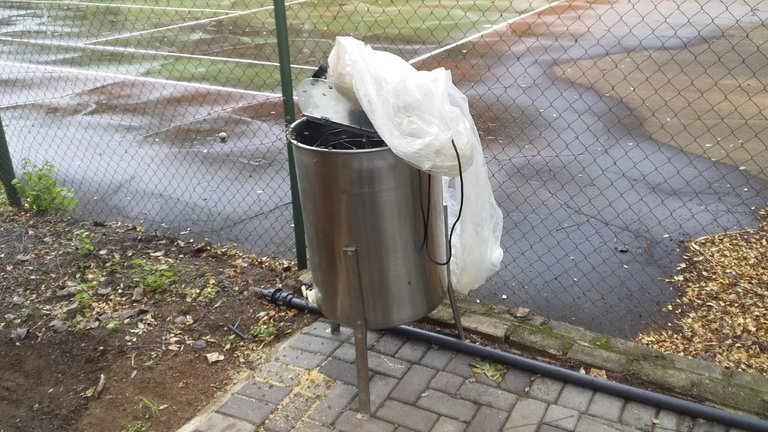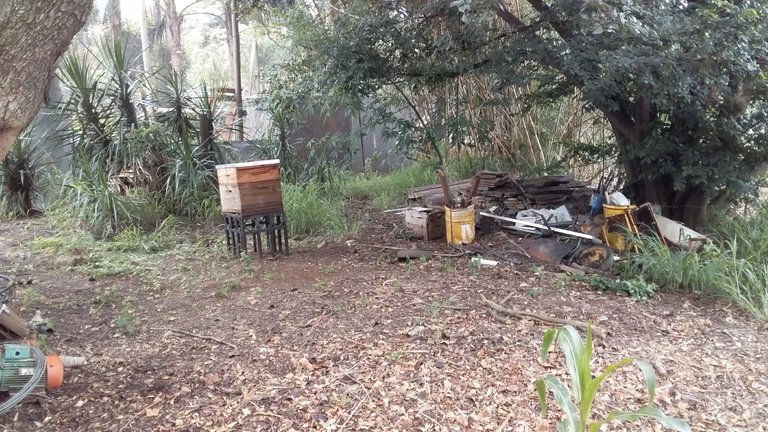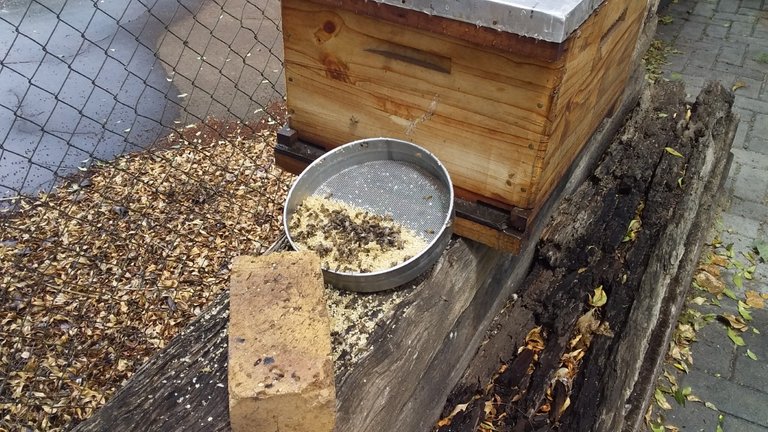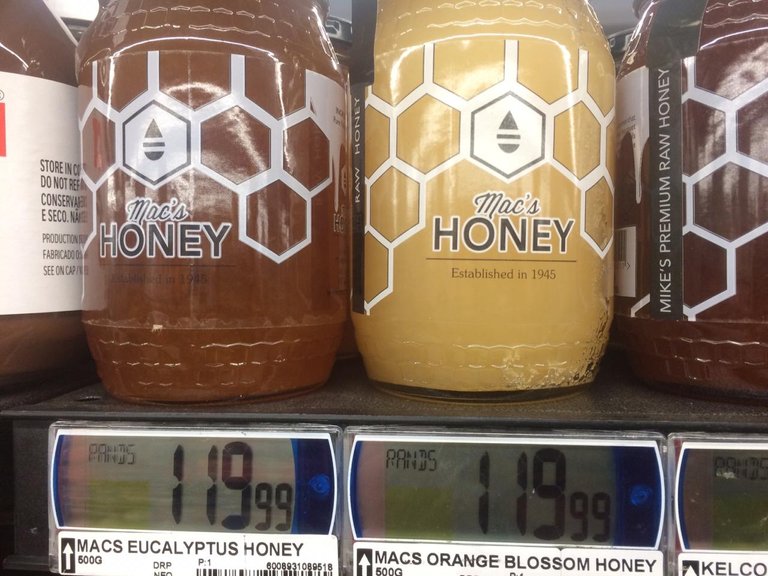Honey Sweet Honey!!
Hey everyone, many cool things about bee-keeping the main one for me is the connection to nature one gets as well as 'doing good' or my bit for nature in housing millions of bees 40-80 thousand bees per swarm or more depending on age.
We recently did a harvest and before spinning out the honey off the combs I had to clean the equipment, I put our honey spinner out for the bees to clean up.

Honey is a sweet, viscous food substance made by honey bees and some related insects.[1] Bees produce honey from the sugary secretions of plants (floral nectar) or from secretions of other insects (such as honeydew), by regurgitation, enzymatic activity, and water evaporation. Bees store honey in wax structures called honeycombs.[1][2] The variety of honey produced by honey bees (the genus Apis) is the best-known, due to its worldwide commercial production and human consumption.[3] Honey is collected from wild bee colonies, or from hives of domesticated bees, a practice known as beekeeping or apiculture.
Honey gets its sweetness from the monosaccharides fructose and glucose, and has about the same relative sweetness as sucrose (table sugar).[4][5] It has attractive chemical properties for baking and a distinctive flavor when used as a sweetener.[4] Most microorganisms do not grow in honey, so sealed honey does not spoil, even after thousands of years.[6][7]
Fifteen millilitres (1 US tablespoon) of honey provides around 190 kilojoules (46 kilocalories) of food energy.[8]
French honey from different floral sources, with visible differences in color and texture
Honey use and production have a long and varied history as an ancient activity. Several cave paintings in Cuevas de la Araña in Spain depict humans foraging for honey at least 8,000 years ago.[ More here as per wikipedia.org https://en.wikipedia.org/wiki/Honey#Classification_by_packaging_and_processing

All the different types of honey as per wikipedia.org Classification by packaging and processing
Generally, honey is bottled in its familiar liquid form, but it is sold in other forms, and can be subjected to a variety of processing methods.
A honeycomb
A variety of honey flavors and container sizes and styles from the 2008 Texas State Fair
Crystallized honey occurs when some of the glucose content has spontaneously crystallized from solution as the monohydrate. It is also called "granulated honey" or "candied honey". Honey that has crystallized (or is commercially purchased crystallized) can be returned to a liquid state by warming.[77]
Pasteurized honey has been heated in a pasteurization process which requires temperatures of 72 °C (161 °F) or higher. Pasteurization destroys yeast cells. It also liquefies any microcrystals in the honey, which delays the onset of visible crystallization. However, excessive heat exposure also results in product deterioration, as it increases the level of hydroxymethylfurfural (HMF)[citation needed] and reduces enzyme (e.g. diastase) activity. Heat also darkens the honey, and affects taste and fragrance.[78]
Raw honey is as it exists in the beehive or as obtained by extraction, settling, or straining, without adding heat (although some honey that has been "minimally processed" is often labeled as raw honey).[79] Raw honey contains some pollen and may contain small particles of wax.
Strained honey has been passed through a mesh material to remove particulate material[80] (pieces of wax, propolis, other defects) without removing pollen, minerals, or enzymes.
Filtered honey of any type has been filtered to the extent that all or most of the fine particles, pollen grains, air bubbles, or other materials normally found in suspension, have been removed.[81] The process typically heats honey to 66–77 °C (150–170 °F) to more easily pass through the filter.[82] Filtered honey is very clear and will not crystallize as quickly,[82] making it preferred by supermarkets.[83] The most common method involves the addition of diatomaceous earth to honey that is heated to 60 °C (140 °F) and passed through filter paper or canvas until a filter cake of diatomaceous earth builds up on the filter.[72]
Ultrasonicated honey has been processed by ultrasonication, a nonthermal processing alternative for honey. When honey is exposed to ultrasonication, most of the yeast cells are destroyed. Those cells that survive sonication generally lose their ability to grow, which reduces the rate of honey fermentation substantially. Ultrasonication also eliminates existing crystals and inhibits further crystallization in honey. Ultrasonically aided liquefaction can work at substantially lower temperatures around 35 °C (95 °F) and can reduce liquefaction time to less than 30 seconds.[84]
Creamed honey, also called whipped honey, spun honey, churned honey, honey fondant, and, in the UK, set honey, has been processed to control crystallization. Creamed honey contains a large number of small crystals, which prevent the formation of larger crystals that can occur in unprocessed honey. The processing also produces a honey with a smooth, spreadable consistency.[85]
Dried honey has the moisture extracted from liquid honey to create completely solid, nonsticky granules. This process may or may not include the use of drying and anticaking agents.[86] Dried honey is used in baked goods,[86] and to garnish desserts.[87]
Comb honey is still in the honeybees' wax comb. It is traditionally collected using standard wooden frames in honey supers. The frames are collected and the comb is cut out in chunks before packaging. As an alternative to this labor-intensive method, plastic rings or cartridges can be used that do not require manual cutting of the comb, and speed packaging. Comb honey harvested in the traditional manner is also referred to as "cut-comb honey".[77]:13[88]
Chunk honey is packed in wide-mouthed containers; it consists of one or more pieces of comb honey immersed in extracted liquid honey.[77]:13
Honey decoctions are made from honey or honey byproducts which have been dissolved in water, then reduced (usually by means of boiling). Other ingredients may then be added. (For example, abbamele has added citrus.) The resulting product may be similar to molasses.
Baker's honey is outside the normal specification for honey, due to a "foreign" taste or odor, or because it has begun to ferment or has been overheated. It is generally used as an ingredient in food processing. Additional requirements exist for labeling baker's honey, including that it may not be sold labeled simply as "honey".[89] https://en.wikipedia.org/wiki/Honey#Classification_by_packaging_and_processing
Here I put out the 2 sieve's out for the bees to clean!

We are cheap and charge R130 per kg, many folks charge that for 500 grams.

Nature the incredible!
Love and light, have an amazing weekend!
Cheer$;)
Credits www.wikipedia.org https://en.wikipedia.org/wiki/Honey#Classification_by_packaging_and_processing
Thank you for sharing this amazing post on HIVE!
Your content got selected by our fellow curator @tibfox & you just received a little thank you via an upvote from our non-profit curation initiative!
You will be featured in one of our recurring curation compilations and on our pinterest boards! Both are aiming to offer you a stage to widen your audience within and outside of the DIY scene of hive.
Join the official DIYHub community on HIVE and show us more of your amazing work and feel free to connect with us and other DIYers via our discord server: https://discord.gg/mY5uCfQ !
If you want to support our goal to motivate other DIY/art/music/homesteading/... creators just delegate to us and earn 100% of your curation rewards!
Stay creative & hive on!
wow thanks a ton much appreciated. Cheer$;)